Starting in 1836 in Paterson, New Jersey, Samuel Colt’s revolver is one of the 10 most influential inventions EVER produced. The Colt Paterson revolver was the first practical revolving-cylinder handgun, and it was made in Paterson, New Jersey.
For years, MLH for some reason, has had a love affair with Paterson, New Jersey. Every time we go, we find something new that amazes us and we say to ourselves, geeze we had no idea. This is just one more of those stories.
“God didn’t create man equal,
…and he started it in Paterson, New Jersey.
Colonel Colt did.”
Some say the quote is a spin on the ‘Blacksmith’s Prayer,’ which goes something like; ‘ God made some men big and some men small, but man made steel and steel made them equal.’
Paterson, New Jersey, has plenty of history and many historic events and venues. The Paterson Falls, known as “The Niagara of New Jersey” is a national treasure and a favorite destination when visiting the area. Much of Passaic’s history happened because of this iconic Passaic River feature.
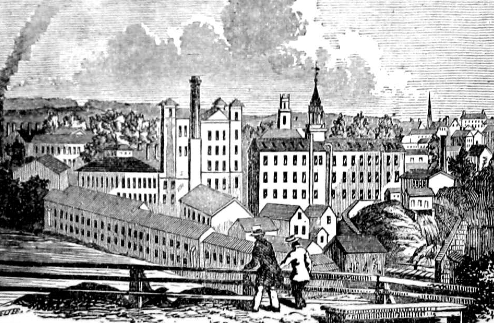
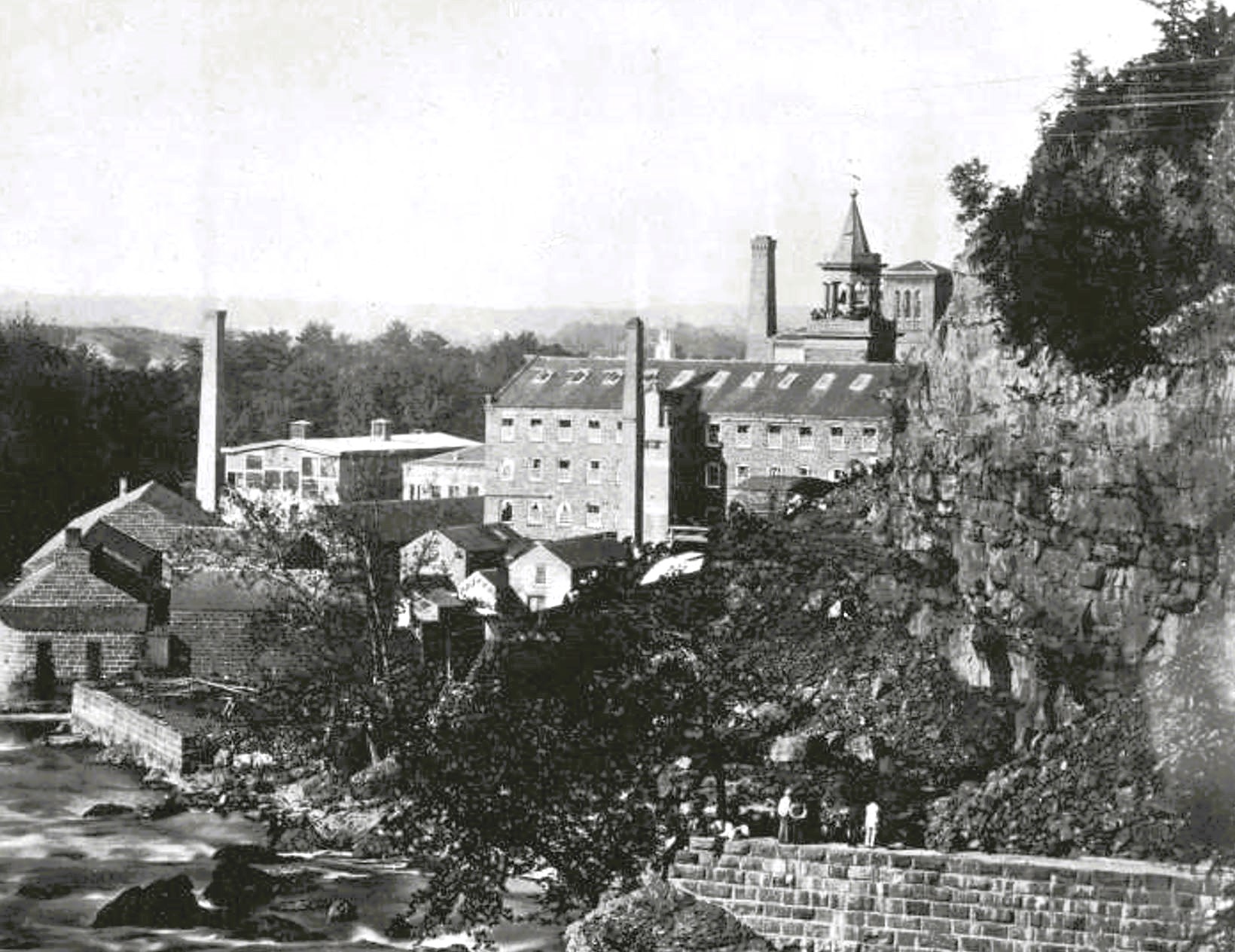
From the Revolutionary War to Alexander Hamilton’s Society for Establishing Useful Manufactures (SUM), being the world’s largest silk manufacturer, to comedian Lou Costello, Paterson has led the way to America’s industrial beginnings. Submarines, locomotives, and don’t forget diners and hot dog joints. Just take a visit to the Paterson Museum and you’ll see. Today though, we’re diving into the life of Colonel Samuel Colt and his Patent Arms Manufacturing facility, Colt’s first manufacturing facility that opened just below Paterson, New Jersey’s Great Falls in 1836.
Samuel Colt
Samuel Colt is not a Jersey guy. He was actually born and raised in Hartford, Connecticut, and is mostly known for his Colt firearms ties to Hartford as well. So why does a Jersey history team want to know about a Connecticut guy? As we found out on a trip to view the revival of the historic Hinchcliff Stadium in Paterson, a resident mentioned that it was time now to revive Colt’s first manufacturing facility just down the river.
Samuel Colt’s greatest achievement was having the vision to create his first revolver, an important yet inevitable design, using interchangeable, machine-made parts. Colt wasn’t just an assembly-line gunsmith; he was more of an inventor and should rightly be called an industrialist more than anything else. I’m not sure if you know he also built underwater mines, designed the first waterproof telegraph cable, or was once a traveling medicine man. All true.
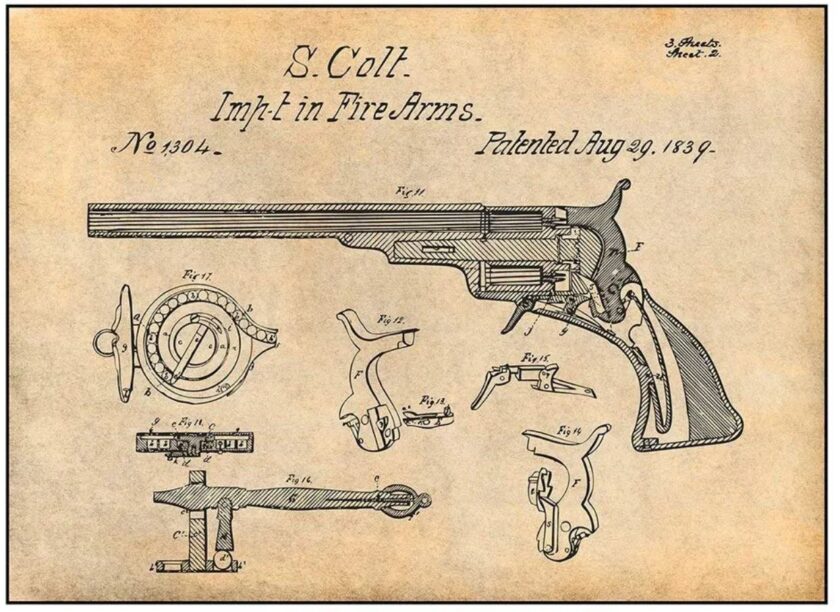
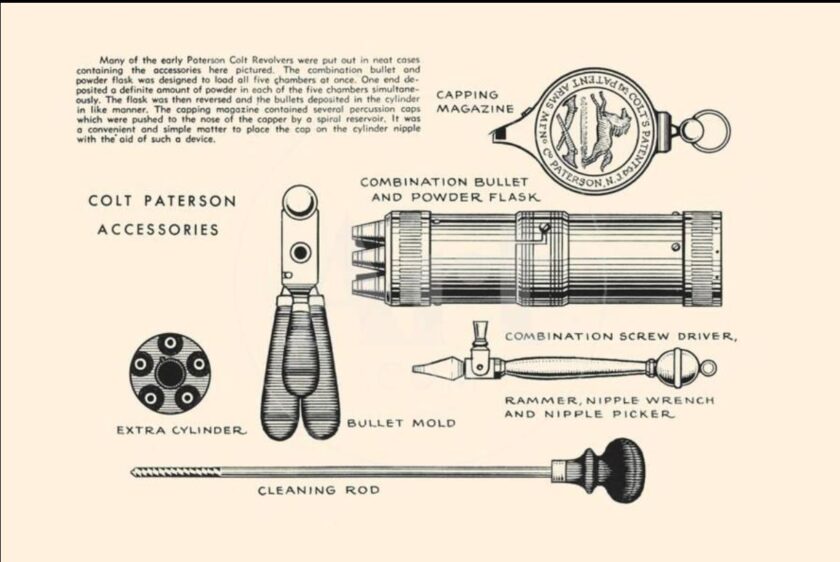
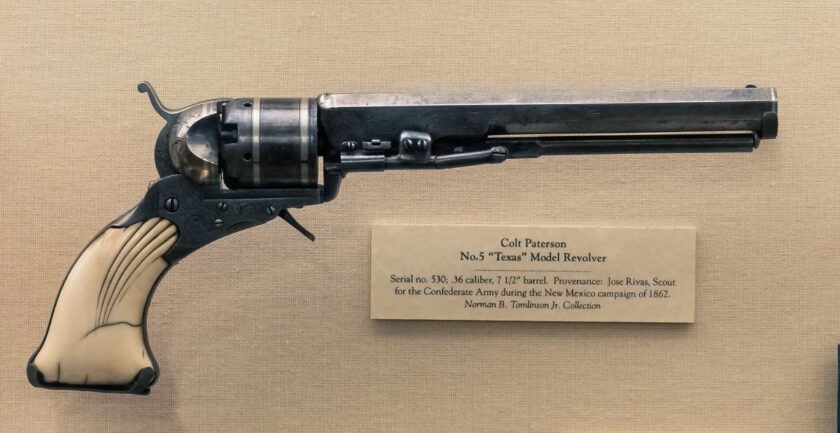
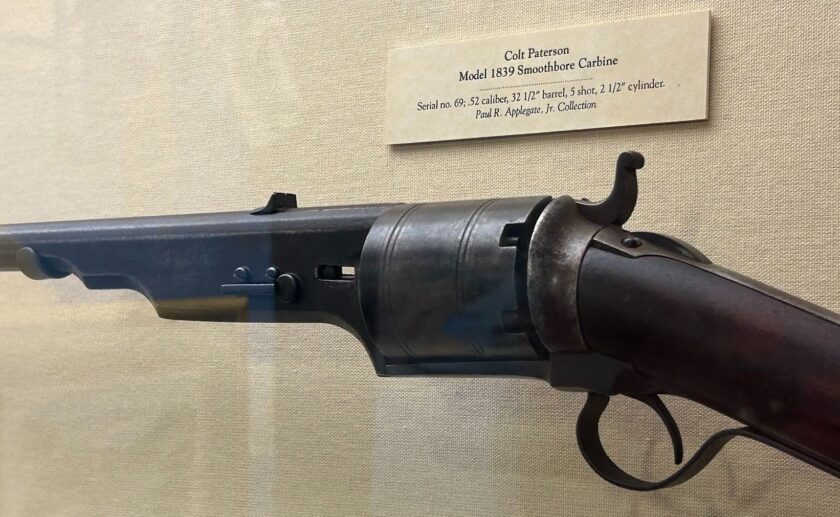
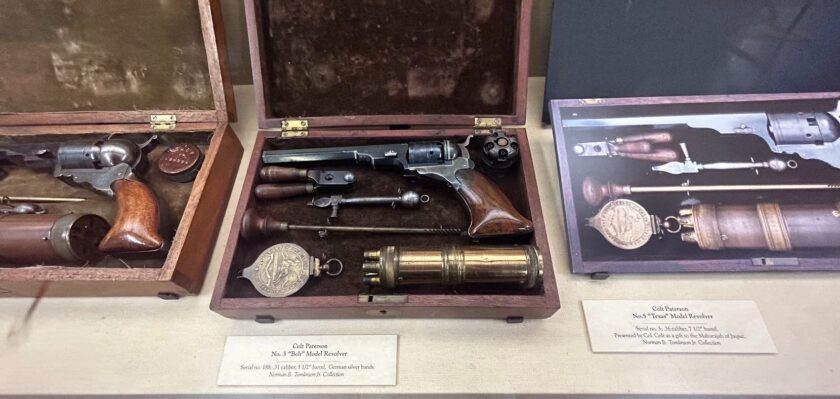
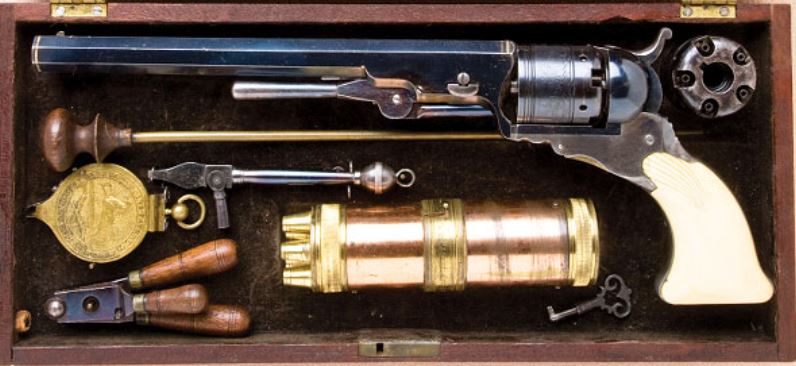
In 2011, the above 1836 Colt Paterson revolver package sold for $977,500 at auction in Texas and was the 4th most expensive gun ever sold.
Colt didn’t invent the revolver and never claimed to have done so. Elisha Collier from Boston patented a revolving flintlock pistol in 1814. Colt’s design took Collier’s pistol a step further, making it more practical by incorporating Colt’s locking bolt mechanism and taking advantage of more reliable modern percussion caps. Oh, and it was cheaper.
Rumor’s spread that Colt sold weapons to both the North and the South in the arms buildup before the Civil War. He sent his last shipment of guns to the South on April 15, 1861, three days after Fort Sumter was fired upon by the Confederate army.
Why some feel Colt betrayed the North.
Colt even thought about building an armory in the South in 1861 and sold 2,000 revolvers to John Forsyth after trade with the South was prohibited. Several prominent newspapers consequently labeled Colt a traitor to the Union. To combat this perception, the State of Connecticut commissioned Colt as a Colonel on May 16, 1861, which is why you’ll sometimes see him referred to as Colonel Sam Colt. It was largely a PR stunt and he was discharged a couple of months later, yet the moniker lived on. He was never an actual “Colonel” in the military. Colt died on January 10, 1862.
Why Paterson
The Colt’s were one of Paterson’s key founding industrial families.
It started with Society for Establishing Useful Manufactures (SUM). Alexander Hamilton, Elias Boudinot and others appointed Peter Colt the first efficient Superintendent of the Society for Establishing Useful Manufactures known as S.U.M.. John Colt, Peter’s son who was the first in the country to weave cotton duck on a power loom and Roswell L. Colt, another son who for many years, was virtually the Society having absorbed its depreciated stock and by his remarkable ability and energy infused life and vigor into the paralyzed corporation. Col. Samuel Colt, who’s now world famous firearm was first manufactured in Paterson at the Old Gun Mill.Morgan, son of Roswell Colt, succeeded his father as Governor Christopher Colt (Sam’s father) became the first to introduce silk machinery into Paterson. Miss Sarah Colt, Peter’s sister, is remembered as the founder as early as 1794 forming the first Sunday school in the State. A history of Paterson’s industrial history would be of little value without a frequent recurrence to the first families of Paterson’s industrial progress.
A History of Industrial Paterson
Everything happens for a reason and Colt’s endeavors in Paterson had a family connection. The S.U.M., the very first corporation in New Jersey, held the hopes of many in the new nation after the Revolutionary War. Such corporations, it was believed, could create economic independence from Great Britain and other nations. Peter Colt of Hartford, comprehended the importance of creating an incubator where industrial businesses could prosper when provided with land and a substantial power supply (water raceways). Peter would later be bought out by his son Roswell Colt.
Hence, Paterson was the industrial capital of the new America when Alexander Hamilton helped create the S.U.M. back in the late 1700s. Paterson became the industrial capital as hydropower was leveraged from the Passaic River and its “raceways,” small water diversions that would power mills along the river, which used water to create steam, which was converted to electricity.
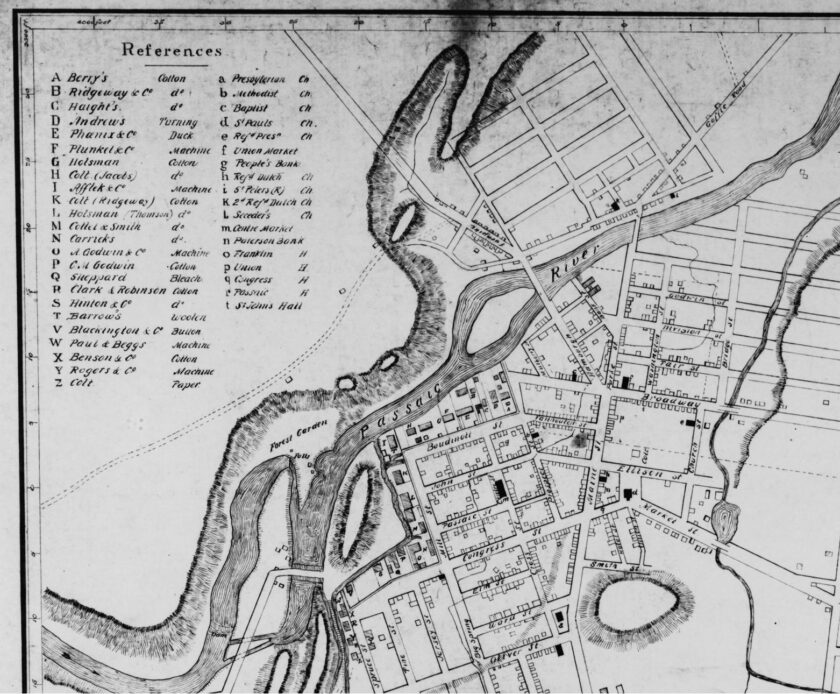
High resolution map – Click Here
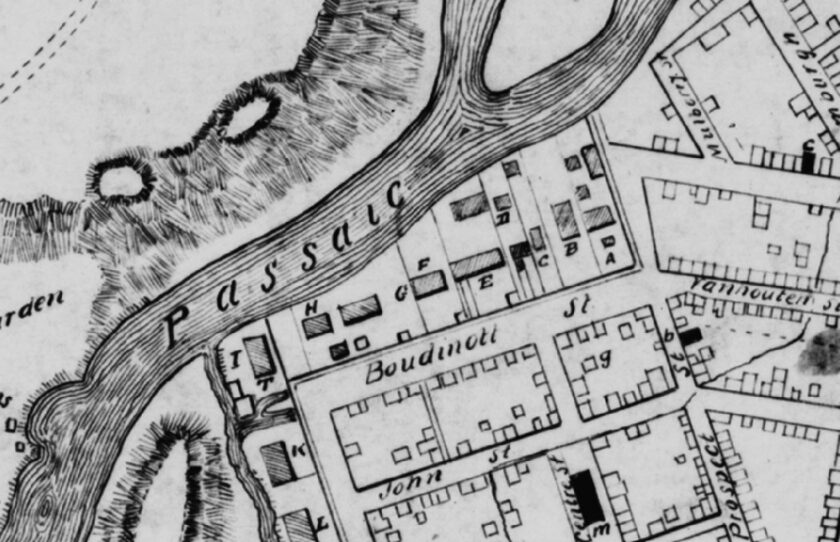
In 1810 Roswell Colt moved into a home on present-day Market Street, opposite today’s Colt Street. Roswell’s father Peter took charge of the S.U.M., clearing land and building fences. John Colt, (Roswell’s brother) through monies invested by Roswell in his absence, became a part owner of a new nail mill in Paterson with two other investors. John also began constructing a substantial home for his father on Mansion Street, now Washington Street near Ellison Street. This home would eventually become Paterson City Hall until the Great Fire of 1902. Colt’s Hill, would be the spot where Roswell Colt would build his mansion nearly fifty years later, in the early 1840’s. Source: Paterson Historical Society.
During Roswell’s separation from his wife Margaret, a young man appeared at his office; 21-year-old second cousin Samuel Colt (they had a common grandfather). He was looking for financial help to produce the new five-shot gun he had invented. Roswell encouraged his young cousin, providing financial resources as well as a factory to build them in. The Patent Arms Manufacturing Company would have its first factory at Paterson.
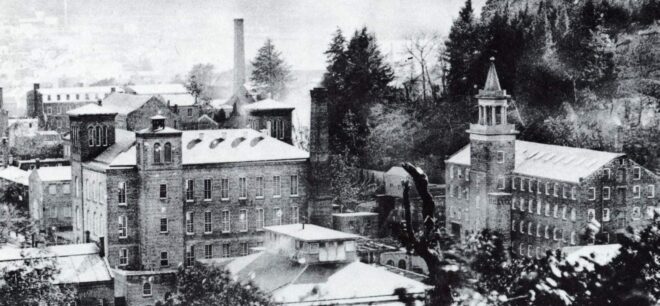
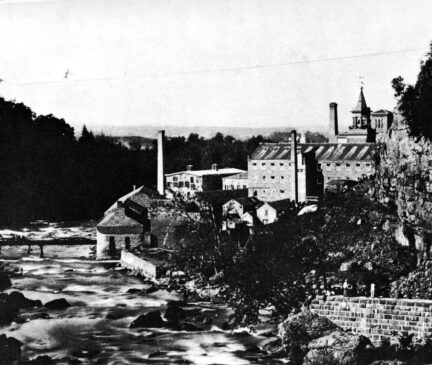
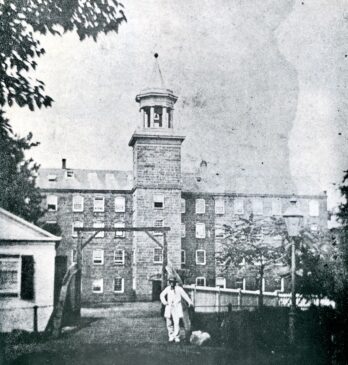
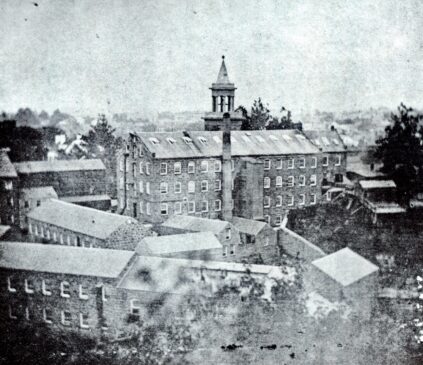
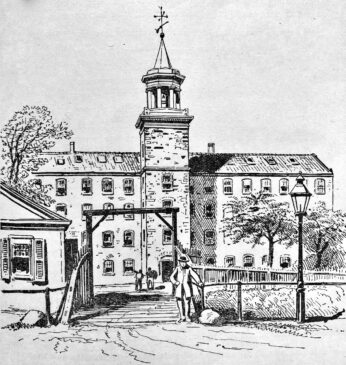
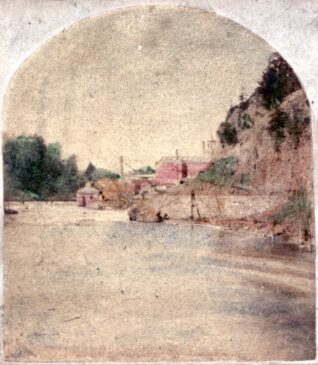
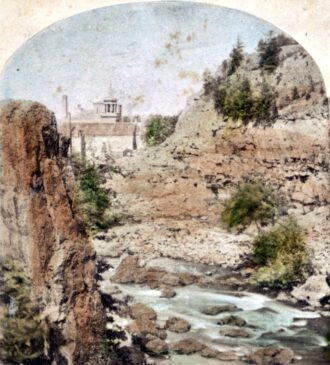
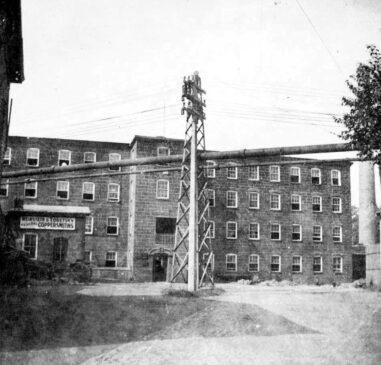
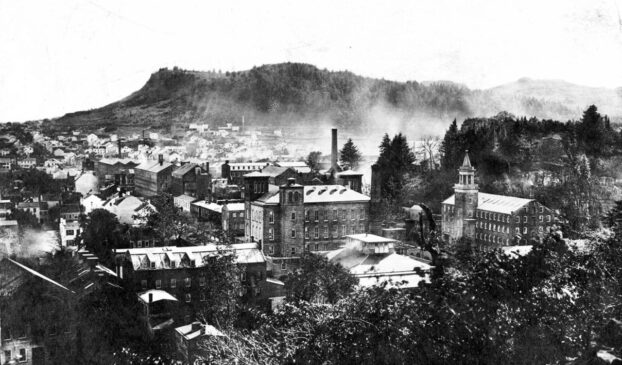
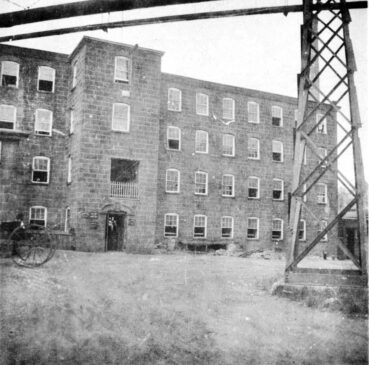
After Colt secured $300,000 in funding, Colt’s Gun Mill was constructed by the Patent Arms Manufacturing Company, which opened on March 5, 1836, on the original site of a rolling mill and nail factory. The Gun Mill was a four-story brownstone structure, with a central projecting stair tower. A weathervane in the shape of a gun capped the bell tower, and encircling the factory was a picket fence, in which each picket was shaped as a wooden gun. Samuel Colt’s first revolvers did not leave his factory until the Fall of 1836.
For several years, Roswell assisted Samuel financially and provided business advice. Roswell paid for Samuel’s sales trip to Florida to sell weapons to the US Army fighting the Seminoles. He also invested in Samuel’s military harbor mining weapon invention, “submarine batteries.” Eventually, the company’s shareholders took control of Patent Arms Manufacturing, and Colt was relegated to sales agent. While the Paterson factory would cease production after only a few years, the “gun mill” would have a new life as Paterson’s first silk mill run by Samuel’s brother Christopher.
The site would serve Samuel Colt for just six years from 1836 to 1842. It is said that over 5,000 rifles and repeating pistols were manufactured at the plant. Samuel’s use of interchangeable parts helped him become one of the first to use the assembly line concept to increase efficiency and keep the price of firearms low.
It wouldn’t be until 1847 when Samuel would open the Colt Patent Manufacturing Company in Hartford, Connecticut.
The Paterson Colt Revolver
It’s 1836, sixty years after the Revolutionary War began and thirty years before the Civil War raged. A young man had a vision that he couldn’t let go of as he dreamed about a repeating firearm that would change the way people could defend themselves. Try, fail, try again. And nothing was guaranteed. Then the Texas Rangers came in and changed Samuel Colt’s trajectory, and the world was changed forever.
Pistols were supposedly called “the great equalizer” because they could be operated by and used against anyone, regardless of size.
Colt came up with the “revolving fire concept” while working on a ship traveling the world after getting into trouble playing with pyrotechnics. It’s been said that on a voyage to Calcutta aboard the ship called Corvo, his idea was inspired by a ship’s wheel (capstan, or windlass). Colt’s pistols incorporated a mechanically rotating and locking cylinder enabling them to fire multiple rounds.
On February 25, 1836, Samuel Colt received a patent for a “revolving gun” with the 20-year US patent number 138, now known as Patent 9430X. The Colt Paterson Percussion Revolver was the first multiple-chamber revolver with a revolving cylinder. Its cylinder could hold five bullets, allowing the user to fire more times without reloading than any other firearm at the time.
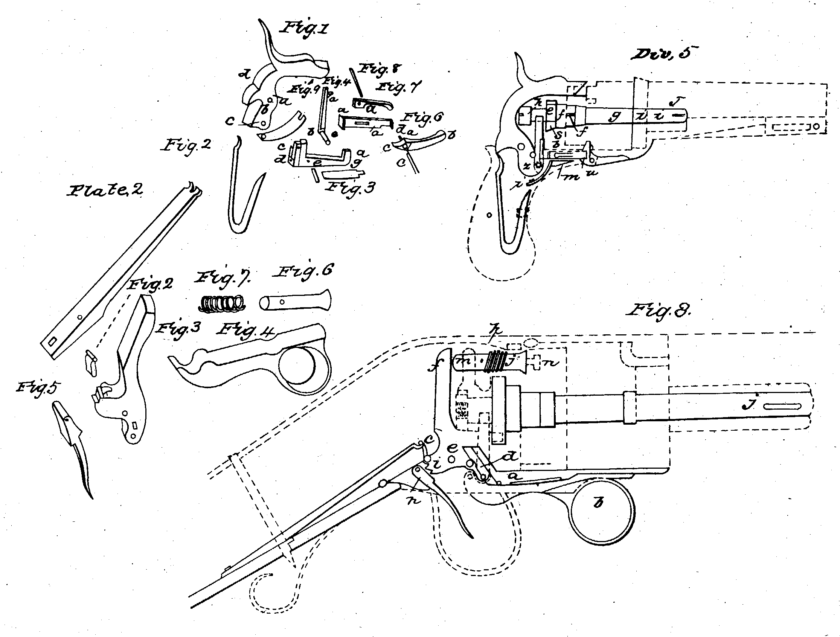
The Colt Paterson was a percussion gun using black powder, lead balls, and percussion caps for ignition. Single action with a five-shot cylinder, the originally designed and produced model had no loading lever and no trigger guard. The trigger folded into the weapon and only became visible upon cocking the hammer, which process was repeated for each shot. This seriously increased the time between successive shots and forced the user to re-establish his grip for each firing. The cylinder was removed to enable loading and capping with a separate loading tool. The user had to disassemble the revolver to reload it partially.
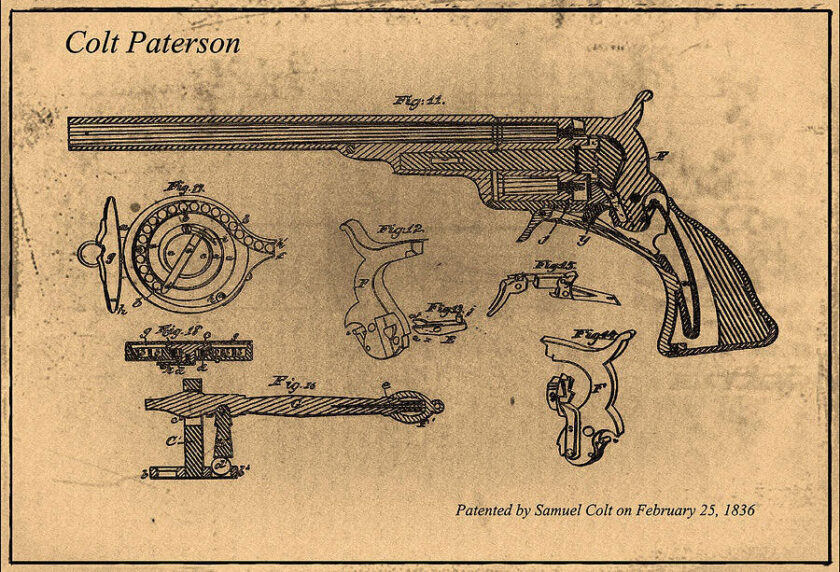
Colt’s mass-produced revolvers were a commercially viable venture. Approximately 2,850 Paterson revolvers were made from 1836 to 1842. However, the gun would eventually fail and be redesigned again and again. Colt died as one of the wealthiest men in America in 1862 at the relatively young age of 47 from an unremarkable cause: gout.
Paterson Revival
In 1983 the mill was closed down and the property was purchased by the Paterson Renaissance Partners. A series of arson fires reduced this building and its surrounding ancillary structures to ruins. Today, the New Jersey Historical Trust has taken an interest in the Colt Gun Mill/Allied Textiles site based on the number of other successful ventures that came from that one location. First a nail manufacturer, the site became the Patent Arms Manufacturing facility to manufacture to Colt’s Paterson Revolver, but later to John T. Pyle and Albert King’s silk manufacturing and Joshua Mason where he invented and produced the Mason Radiator. However, the Allied Textile Mills made the facility one of the largest textile manufacturing facilities in the country. The facility would continue to be used as Allied Textile Mills until 1983 when the facility was vacated.
“In America, where manual labor is scarce and expensive, it was imperative to devise means for producing these arms with greatest rapidity and economy.”
Colt delivered a speech in London before the Institution of Civil Engineers, explaining to the audience that his manufacturing methods were as important as his guns which was the start of America’s industrial revolution.
The Colt Gun Mill will become the setting for an outdoor museum on water power since the chronology of the Gun Mill’s power source waterwheel to steam to electricity mirrors the evolution of American industry.
There are no bones about it that Paterson, New Jersey has gone through many boom and bust periods.
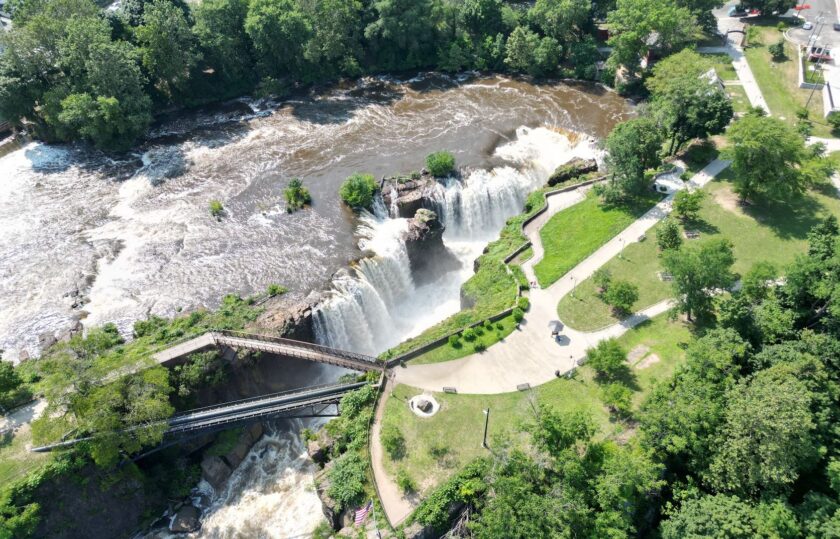
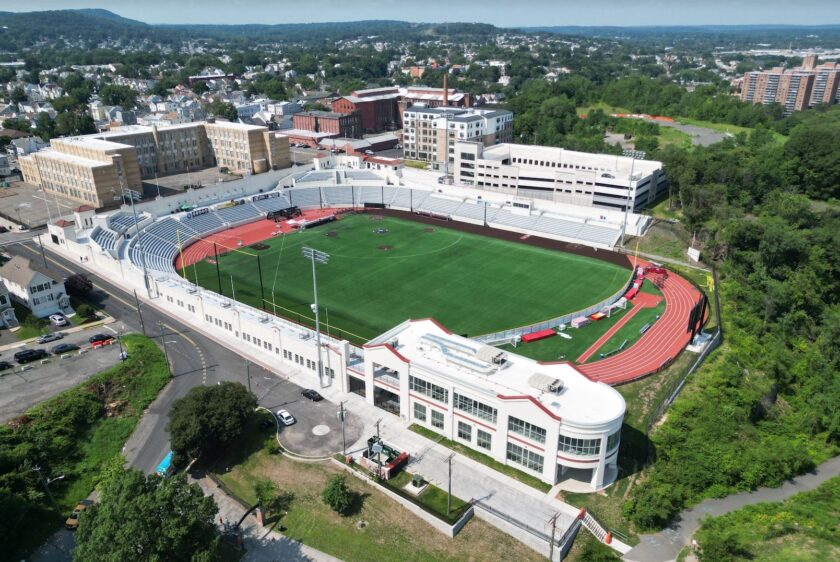
Will the Colt Mill manufacturing facility be next?
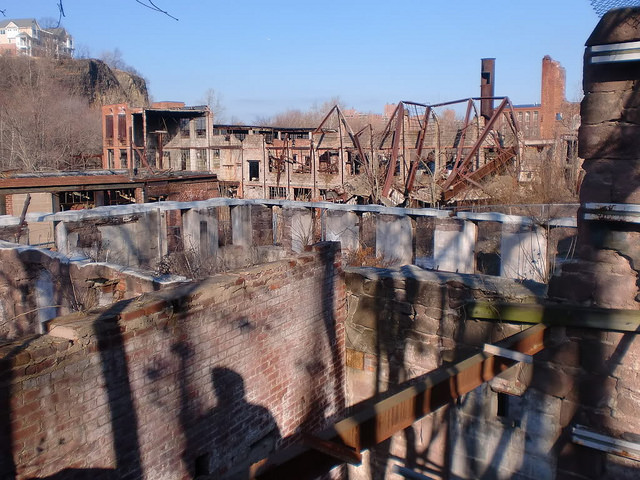
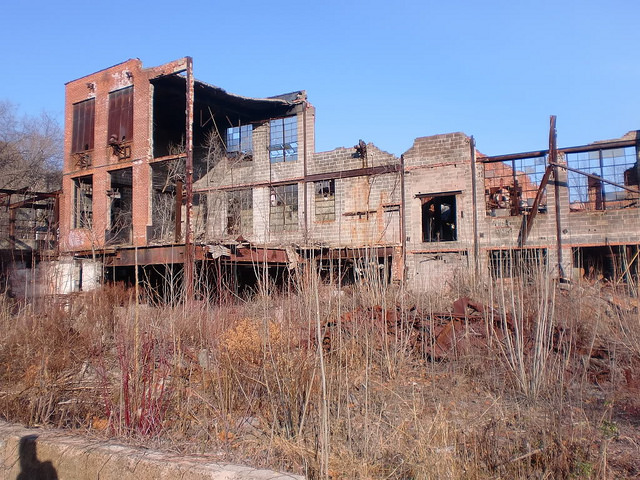
The mill still sits on a prominent 7-acre site within the 90-acre Great Falls/S.U.M. National Historic District. Since 1988 the site has been listed as a Priority One threatened National Historic Landmark in the U.S. Department of the Interior’s Annual Report to Congress. The NJHT has made two grant awards: $359,000 (1996); and $50,000 (2020). In 2021, Paterson Municipal officials were seeking an additional $500,000 in grant funding from the New Jersey Department of Environmental Protection to stabilize the historic Colt Gun Mill deep inside the Great Falls National Historical Park. Funds from the Urban Parks Initiative will be used to protect what remains of the Colt Gun Mill and the nearby smokestacks. So what’s it gonna be Paterson? Fraud, embezzlement, or restoration? Only time will tell.
Interactive Map – Paterson History
More Paterson History Tidbits
Paterson, New Jersey facts you might not have known:
- Paterson was named for William Paterson, statesman, signer of the Constitution, and Governor of New Jersey, who signed the 1792 charter that established the Town of Paterson
- Nickname: Silk City
- Colt’s Hill – Samuel Colt’s 2nd cousin Roswell Lyman Colt, acquired great wealth in the shipping industry, was married in 1811 to Margaret Oliver, and became the head of the S.U.M. in 1814. He was the son of Peter Colt, a Revolutionary War veteran and one of the founders of Paterson, NJ. He chose this hill to erect a grand estate, at the city’s center, which would later be called Colt’s Hill. The prominent sandy hill is bounded by (now) Main, Ward, Prince and Grand Streets.
- The Paterson High School athletic teams are called “The Colts”
- The Paterson Evening News was printed by the “Colt Press”
- Third largest city in New Jersey – 159,732
- 2nd largest per capita Muslim population in the US
- The Great Falls are 77 feet high
- Samuel Colt is known to have said, ”The good people of this world are very far from being satisfied with each other, and my arms are the best peacemakers.” This popular saying also concerns Samuel Colt: ”God created men. Colonel Colt made them equal.” Charles Martin, Thunder, and Rain.
- In 1983, Paterson was the fifth poorest city in the United States.
- With a Mayor-Council plan, the Mayor is the chief executive and is responsible for administering the City’s activities.
- Lou Costello often referred to his hometown of Paterson in his comedy routines with Bud Abbott. The plot of the June 28, 1945, episode of the Abbott & Costello radio show is about the City of Paterson inviting him back for “Lou Costello Day
- The Great Falls was featured in the first season of the HBO crime drama The Sopranos, both in the pilot and in the episode Pax Soprana as the place where Junior Soprano’s friend’s grandson committed suicide after taking poor designer drugs; as a favor, Junior Soprano had Mikey Palmice and another individual toss the dealer, Rusty Irish, off the bridge over the falls.[240] Other locations throughout the city were used in the series, as much of the show was shot on location in North Jersey.

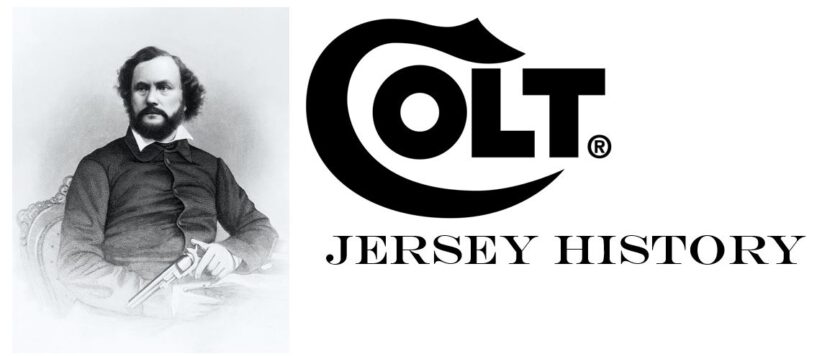
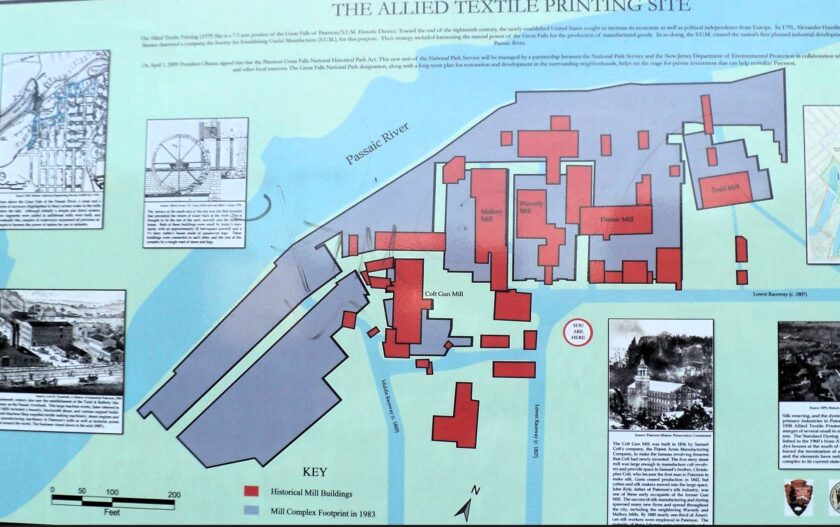
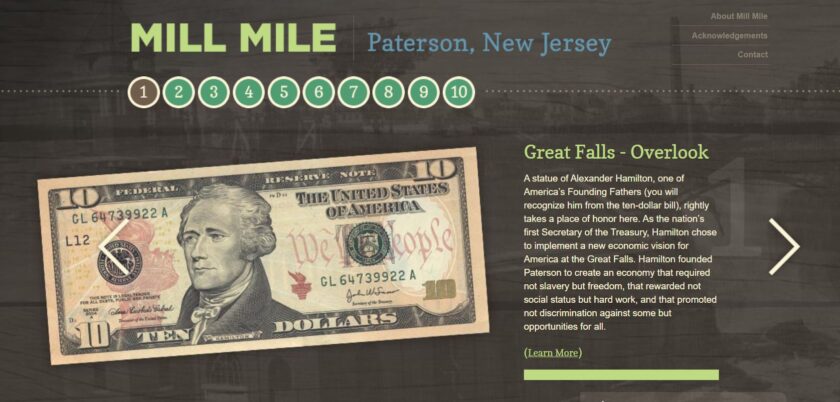
The latest to revive Paterson according to locals…..cigars. Who knew